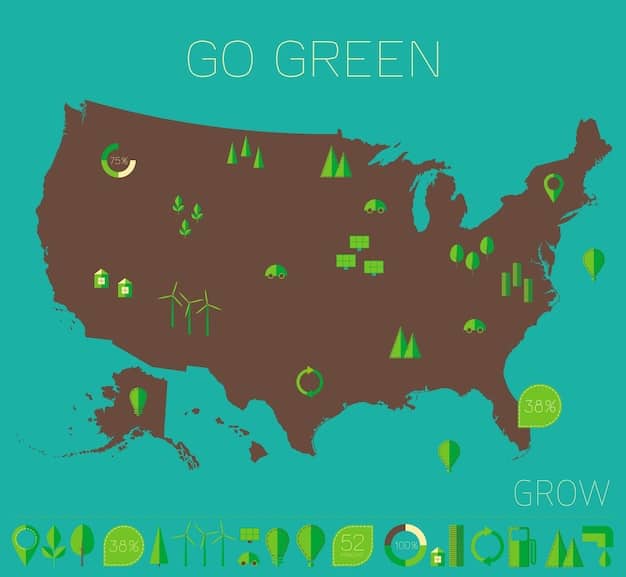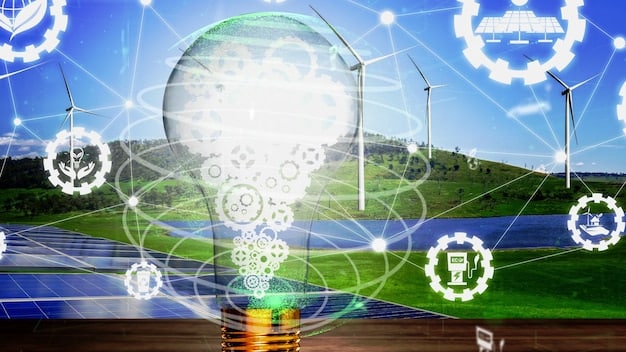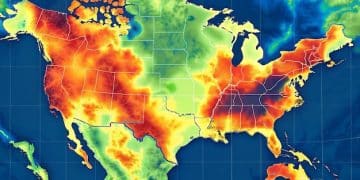2025 IPCC Report: Impact on US Climate Policy Explained

The updated 2025 IPCC Report is anticipated to significantly reshape US climate policy by providing more localized data, refined economic assessments of climate impacts, and clearer pathways for mitigation and adaptation, prompting a re-evaluation of current sectoral strategies and international commitments.
The question of How Will the Updated 2025 IPCC Report Impact US Climate Policy? is not merely academic; it’s a critical inquiry into the future trajectory of America’s environmental strategy. The Intergovernmental Panel on Climate Change (IPCC) reports serve as the authoritative scientific backbone for global climate action, and each new assessment brings refined data, updated projections, and increasingly urgent calls for change. For the United States, a key global emitter and economic powerhouse, the 2025 update promises to be a pivotal moment, shaping legislative priorities, regulatory frameworks, and perhaps even public discourse surrounding climate change.
understanding the IPCC Process and its Political Weight
The Intergovernmental Panel on Climate Change (IPCC) is not a research body but rather an organization that assesses the vast body of scientific literature related to climate change. Its reports represent a consensus of thousands of scientists worldwide, meticulously peer-reviewed and approved by 195 member governments. This rigorous process lends the IPCC’s findings immense scientific credibility and, consequently, significant political weight.
For the United States, the IPCC reports act as a fundamental reference point for climate policy. While domestic science agencies like NOAA and NASA contribute significantly, the IPCC synthesizes global research, providing a comprehensive and internationally recognized baseline. Previous IPCC reports have directly influenced key policy decisions, from setting emissions reduction targets to informing investments in renewable energy and climate resilience infrastructure. The 2025 report is expected to continue this trend, perhaps with even greater precision and urgency.
the evolving nature of ipcc assessments
Each successive IPCC assessment builds upon the last, incorporating new scientific discoveries, improved climate models, and more refined economic and social analyses. The 2025 report, likely building on the Sixth Assessment Report (AR6) cycles, will integrate data from the most recent extreme weather events, advancements in carbon cycle understanding, and more nuanced projections for regional impacts. This evolution demands a flexible and responsive policy apparatus.
For instance, earlier reports might have offered broad global projections, but newer iterations often provide increasingly localized data. This regional specificity is invaluable for US policymakers, as climate impacts vary dramatically across states, from sea-level rise on the coasts to drought in the West and extreme heat in the Southwest. Understanding these localized threats allows for the formulation of more targeted and effective policies.
- Enhanced Regional Data: More precise projections for specific US regions, addressing localized vulnerabilities.
- Refined Economic Models: Improved cost-benefit analyses of climate action versus inaction, aiding policy justification.
- New Mitigation Pathways: Exploration of emerging technologies and social changes for faster decarbonization.
- Updated Adaptation Strategies: Best practices and case studies for building resilience in key sectors.
The political weight of these findings stems from their consensus-driven nature. When the global scientific community, and by extension, global governments, endorse these findings, it becomes significantly harder for any single nation to dismiss or ignore the imperative for action. This pressure, both scientific and diplomatic, shapes the domestic policy landscape.
In essence, the IPCC provides the “what and why” of climate change, giving policymakers a robust, evidence-based foundation upon which to build their “how.” The 2025 report will likely narrow the window of opportunity for effective action, pushing US policy towards more aggressive and immediate interventions.
anticipated scientific refinements in the 2025 IPCC Report
The upcoming 2025 IPCC report is expected to synthesize the latest scientific breakthroughs, presenting a more granular and perhaps more alarming picture of climate change than previous assessments. Key areas of refinement will likely include improved climate modeling, a deeper understanding of feedback loops, and more precise projections for extreme weather events.
One major area of focus for the 2025 report will undoubtedly be the continued refinement of Earth System Models. These sophisticated computer models simulate the interactions between the atmosphere, oceans, land, and ice, providing more accurate long-term climate projections. Expect the new report to incorporate advancements in cloud physics, aerosol effects, and ocean heat uptake, which are crucial for reducing uncertainties in future warming predictions.
Another critical aspect is the understanding of climate feedback loops. These are processes that can amplify or dampen the initial warming. For example, melting permafrost can release potent greenhouse gases like methane, creating a positive feedback loop that accelerates warming. The 2025 report will likely provide updated assessments on the tipping points associated with these feedbacks, such as the potential collapse of major ice sheets or changes in ocean circulation, which could have profound impacts on global climate patterns, including those directly affecting the US.
- More Robust Climate Models: Integrating higher resolution data and complex process representations.
- New Insights on Tipping Points: Updated analysis of irreversible changes in Earth’s climate system.
- Regional Impact Specificity: Enhanced data regarding localized effects within the US, such as drought, extreme heat, and sea-level rise.
- Carbon Cycle Dynamics: Better understanding of natural carbon sinks and their diminishing capacity.
The report will also probably offer more refined projections for extreme weather events. Recent years have seen an unprecedented frequency and intensity of heatwaves, floods, droughts, and wildfires across the globe, including within the US. The 2025 assessment will likely strengthen the attribution science linking these events to human-induced climate change, providing more concrete evidence for policymakers advocating for resilience measures and emissions reductions.
Furthermore, expect the report to delve into refined carbon budget calculations – how much more carbon can be emitted while still having a chance to limit warming to 1.5°C or 2°C. These budgets are steadily shrinking, and the 2025 report will likely emphasize the urgency of drastic decarbonization measures. The scientific community’s ability to track and attribute greenhouse gas emissions to specific sources has also improved, which could empower more targeted policy interventions in sectors like energy, agriculture, and industry.
Ultimately, these scientific refinements will provide US policymakers with an even more compelling and detailed roadmap for action. The increased certainty and specificity of the findings will make it harder to delay or dismiss climate policy interventions, framing climate action not just as an environmental imperative, but also as an economic and national security necessity.

direct policy implications for US sectors
The updated 2025 IPCC report’s findings will cascade into direct policy implications across various critical sectors in the United States. From energy and infrastructure to agriculture and public health, the report’s refined data and deepened understanding of climate impacts will necessitate a re-evaluation of current strategies and the aggressive pursuit of new, more resilient, and sustainable approaches.
The energy sector will likely face the most profound shifts. The IPCC will undoubtedly reinforce the urgency of transitioning away from fossil fuels. This could translate into stronger incentives for renewable energy deployment (solar, wind, geothermal), tighter regulations on emissions from power plants, and potentially accelerated timelines for phasing out coal and natural gas infrastructure. Policy initiatives such as carbon pricing, clean energy standards, and expanded tax credits for clean tech will gain renewed scientific backing.
Infrastructure development will also be significantly impacted. With more precise regional climate projections, policies for new construction and existing infrastructure upgrades will need to account for increased risks like extreme heat, flooding, and sea-level rise. This means bolstering building codes, investing in resilient transportation networks, and developing smart city initiatives that can withstand future climate shocks. Funds for adaptation and resilience projects will likely become a more prominent feature of federal and state budgets.
agriculture and land use challenges
The agricultural sector, highly sensitive to climate variability, stands to be significantly affected. The report’s insights into shifting growing seasons, water stress, and pest migration will demand new policies supporting climate-smart agriculture. This could include federal programs for drought-resistant crops, improved irrigation techniques, soil carbon sequestration incentives, and strategies for reducing agricultural methane and nitrous oxide emissions. Land-use policies will also need to evolve to protect vital ecosystems that act as carbon sinks.
- Energy: Accelerated transition to renewables, stricter emissions standards, potential carbon pricing.
- Infrastructure: Investments in climate-resilient designs, updated building codes, coastal protection.
- Agriculture: Support for drought-resistant farming, soil health initiatives, reduced agricultural emissions.
- Public Health: Enhanced early warning systems for heatwaves, air quality regulations, vector-borne disease control.
- Water Resources: Improved water management, conservation efforts, desalinization projects in arid regions.
In the realm of public health, the report’s detailed analysis of the health impacts of climate change (e.g., heat-related illnesses, respiratory problems from wildfires, vector-borne diseases) will likely spur new public health policies. This might involve improved early warning systems for extreme weather, enhanced air quality regulations, and increased funding for research into climate-sensitive diseases. The focus will shift from reactionary measures to proactive prevention and public awareness campaigns.
Finally, water resource management will see significant policy responses. With better projections on drought severity and changes in precipitation patterns, policies will need to prioritize water conservation, efficient allocation, and investment in alternative water sources like desalination and wastewater recycling, particularly in arid regions of the US. The cross-cutting nature of climate impacts means that these sectoral policies will often need to be integrated and coordinated to achieve holistic climate resilience.
economic ramifications and opportunities
The updated 2025 IPCC report will undoubtedly underscore the significant economic ramifications of climate change, but also highlight the immense opportunities embedded in climate action. For the US, these economic considerations will be a central driver for policy decisions, shifting the narrative from a purely environmental concern to one of economic stability, competitiveness, and innovation.
The report is expected to provide more robust economic assessments of climate impacts, detailing the soaring costs associated with inaction. This includes the direct costs of extreme weather events (damage to infrastructure, property, and agriculture), health impacts, and disruptions to supply chains. For the US economy, which has already seen billions of dollars in climate-related damages annually, these updated figures will strengthen the economic case for substantial investment in both mitigation and adaptation.
Conversely, the report will highlight the economic opportunities presented by the transition to a low-carbon economy. The burgeoning clean energy sector, for example, is a significant job creator. Investment in renewables, electric vehicles, energy efficiency, and sustainable agriculture can spur innovation, create new industries, and enhance national competitiveness in the global green economy. Policies that incentivize these sectors, such as tax credits, R&D funding, and workforce development programs, will gain traction.
the cost of inaction versus the benefits of investment
The IPCC’s economic modeling will likely present a clearer picture of the cost-benefit analysis. While initial investments in decarbonization might seem steep, they will be framed against the exponentially higher costs of dealing with unmitigated climate change. This framing is crucial for policymakers seeking to justify significant public and private sector spending on climate initiatives. The report may also emphasize the long-term economic stability gained by reducing reliance on volatile fossil fuel markets.
- Increased Disaster Costs: Detailed projections of economic losses from climate-driven extreme events.
- Job Creation in Green Sectors: Analysis of employment growth in renewable energy, EV manufacturing, and sustainable tech.
- Supply Chain Resilience: Economic benefits of stable climate conditions for agriculture and global trade.
- Investment Opportunities: Attracting capital to climate tech and sustainable infrastructure.
Furthermore, the report might delve into the economic implications of climate justice, addressing how climate impacts disproportionately affect vulnerable communities and how equitable climate policies can foster broader economic benefits. Investments in climate resilience for these communities can reduce long-term social and economic disparities, contributing to overall national prosperity.
From an international trade perspective, countries that are leaders in green technologies and sustainable practices will likely gain a competitive edge. The US, by accelerating its climate action, can position itself as a global leader, exporting clean technologies and expertise. This economic leadership reinforces the national security argument for climate action, ensuring resilience and prosperity in a rapidly changing global landscape.
In essence, the 2025 IPCC report will not only quantify the risks but also illuminate the economic pathways to a more resilient and prosperous future. The insights will arm policymakers with powerful arguments for robust climate policies, framing them not as a burden, but as a strategic investment in the nation’s economic future.
international commitments and diplomatic leverage
The 2025 IPCC report will undoubtedly exert significant influence over US international climate commitments and diplomatic leverage on the global stage. As the world’s largest historical emitter and a critical actor in global climate negotiations, the United States’ posture is closely watched. The new findings will likely heighten pressure on the US to not only meet but potentially exceed its existing climate pledges, while simultaneously bolstering its ability to lead international climate action.
The IPCC’s scientific consensus provides the foundational evidence for international climate agreements, such as the Paris Agreement. If the 2025 report indicates a more rapid progression of climate impacts or a shrinking carbon budget, it will directly inform the ambition of Nationally Determined Contributions (NDCs) that countries submit under the Paris Agreement. For the US, this could mean pressure to update its NDC with more aggressive emissions reduction targets and clearer timelines for achieving net-zero emissions.
Furthermore, the report’s insights will be instrumental in the ongoing discourse around climate finance. Developed nations, including the US, have committed to mobilizing significant climate finance for developing countries, both for mitigation and adaptation. If the report highlights increased vulnerability in developing nations or a greater need for adaptation measures, it could intensify calls for the US to scale up its contributions to international climate funds and support other nations in their climate transitions.
reasserting global climate leadership
The US has historically played a crucial role in global climate negotiations, albeit with periods of withdrawal. A strong response to the 2025 IPCC report by enacting robust domestic policies would significantly re-establish US credibility and diplomatic leverage. It would allow the US to push for higher ambition from other major emitters and foster greater international cooperation on climate solutions. Conversely, a weak or delayed response risks eroding trust and undermining collective global efforts.
- NDC Ambition: Potential for more aggressive US national emissions reduction targets.
- Climate Finance: Increased pressure to contribute to international funds for mitigation and adaptation in developing nations.
- Technological Transfer: Opportunities for the US to lead in sharing clean technologies globally.
- Multilateral Engagement: Enhanced role in international forums and negotiations where climate is a key agenda item.
Beyond formal commitments, the report can also shape informal diplomatic efforts and bilateral relationships. For instance, the US might leverage the scientific findings to engage in specific dialogues with countries heavily reliant on fossil fuels, offering assistance and partnerships for their energy transitions. It could also strengthen collaborations with scientific bodies and climate initiatives worldwide, sharing expertise and fostering joint research.
The report also provides data that can be used to hold other nations accountable for their climate pledges. By offering clear scientific benchmarks, the US can advocate for greater transparency and more robust verification mechanisms in international climate action. This strategic use of scientific insights can drive more effective global policy outcomes.
In essence, the 2025 IPCC report is not just a scientific document; it’s a diplomatic tool. It will provide the US with both a moral imperative and a factual basis to reassert its leadership in the global fight against climate change, fostering more ambitious international commitments and more effective collective action.
challenges and opportunities for policy implementation
Implementing climate policy in the United States, even with the compelling scientific backing of the 2025 IPCC report, presents a multifaceted array of challenges and opportunities. The US’s fragmented political landscape, diverse economic interests, and varied regional vulnerabilities mean that national policy formulation requires careful navigation and strategic foresight.
One of the primary challenges lies in overcoming political polarization. Climate change has, unfortunately, become a partisan issue in the US, leading to policy reversals with changes in administration. The 2025 IPCC report, by providing updated and potentially more urgent data, might help shift public opinion and build broader, bipartisan consensus, but this is far from guaranteed. Effective implementation will require sustained public education and engagement campaigns to bridge ideological divides.
Another significant hurdle is the economic transition itself. While the shift to a green economy presents immense opportunities, it also entails challenges for traditional industries and their workforces. Policies must be designed to ensure a just transition, providing support, retraining, and new economic opportunities for communities reliant on fossil fuel industries. Without careful management, economic dislocation can fuel political opposition to climate policies.
technological innovation and infrastructure investment
On the opportunity front, technological innovation is a key enabler. Advances in renewable energy, battery storage, carbon capture, and sustainable agriculture are accelerating, making ambitious climate targets more achievable and cost-effective. Policy can foster this innovation through research and development funding, competitive grants, and market incentives, positioning the US at the forefront of the global green technology revolution.
- Political Will: Overcoming partisan divides and building durable bipartisan support.
- Economic Transition: Ensuring a just transition for communities affected by decarbonization.
- Technological Deployment: Accelerating the adoption of existing clean technologies and fostering new innovations.
- Infrastructure Modernization: Funding and implementing climate-resilient infrastructure across the nation.
- Regulatory Frameworks: Developing clear, enforceable regulations to drive emissions reductions and adaptation.
Infrastructure investment is another critical opportunity. The IPCC report will highlight where significant infrastructure upgrades are needed for resilience against extreme weather and sea-level rise. This presents an opportunity to “build back better” and “build forward smarter,” creating jobs, stimulating local economies, and future-proofing American communities. Federal funding, leveraging private investment, will be crucial here.
Finally, developing robust regulatory frameworks and enforcement mechanisms will be vital. Policies need to be clear, consistent, and enforceable to drive compliance and achieve desired outcomes. This includes setting emissions standards, energy efficiency mandates, and land-use planning guidelines that align with climate goals. The challenge will be crafting regulations that are effective without stifling economic growth or creating undue burdens, particularly for small businesses.
In summary, while the 2025 IPCC report will provide a clear scientific imperative, the success of US climate policy will ultimately depend on navigating these complex political, economic, and technological landscapes, transforming challenges into opportunities for strategic investment and sustainable growth.

public awareness and engagement
The impact of the 2025 IPCC report on US climate policy will not solely depend on scientific findings and political will; public awareness and sustained engagement will play a pivotal role. A well-informed and engaged populace can create the necessary political pressure for comprehensive climate action, provide support for new policies, and foster community-level resilience initiatives.
The report’s release will present a significant opportunity for scientific communicators, policymakers, and advocacy groups to translate complex climate science into accessible information for the broader public. Highlighting the localized impacts on US communities—be it increased hurricane intensity in the Southeast, prolonged droughts in the Southwest, or extreme heatwaves in urban centers—can make the abstract concept of global warming tangible and relevant to everyday lives.
Effective public engagement goes beyond simply disseminating information; it involves fostering dialogue and empowering individuals to participate in solutions. This can include community workshops, citizen science initiatives, and local climate action planning. When people understand how climate change affects their immediate surroundings and livelihoods, they are more likely to support policies that address these specific challenges, whether through voting, volunteering, or advocating for change.
media role and youth activism
The media will play a crucial role in shaping public perception. Responsible and accurate reporting of the IPCC’s findings, avoiding sensationalism while conveying urgency, is paramount. This includes showcasing both the challenges and the innovative solutions being developed across the country. The proliferation of digital media platforms also offers new avenues for direct engagement with diverse audiences, allowing for targeted messaging and interactive content.
- Localized Impact Communication: Translating global science into relevant local effects.
- Citizen Science Programs: Engaging the public in data collection and environmental monitoring.
- Youth Engagement: Empowering younger generations to advocate for their future.
- Digital Storytelling: Using multimedia platforms to convey climate realities and solutions.
Youth activism and grassroots movements will continue to be a powerful force. Younger generations, acutely aware that they will bear the brunt of climate change, are increasingly vocal and organized. Their passion and advocacy can push policymakers for more ambitious commitments and hold them accountable for inaction. The 2025 report will likely galvanize further youth-led climate strikes and environmental justice movements, amplifying the demand for policy change.
Ultimately, a shift in public consciousness, moving from passive awareness to active engagement, is crucial for the long-term success of US climate policy. The 2025 IPCC report provides the scientific impetus, but it is the sustained and informed involvement of the American public that will determine the true depth and durability of the policy response.
| Key Area | Brief Impact |
|---|---|
| 🔬 Scientific Precision | More localized data for US regions, refining climate models. |
| ⚡ Energy Transition | Accelerated shift to renewables, stricter emissions regulations. |
| 💸 Economic Outlook | Quantified costs of inaction, highlighting green job creation. |
| 🌐 Global Leadership | Strengthened US role in international climate negotiations and finance. |
frequently asked questions
▼
The IPCC (Intergovernmental Panel on Climate Change) is the leading international body for assessing climate change. Its reports synthesize global scientific research, providing authoritative assessments. The 2025 report is crucial for US policy as it offers updated, refined data on climate impacts and pathways, forming the scientific basis for future legislative and regulatory decisions, influencing everything from energy policy to infrastructure planning.
▼
The 2025 report is expected to provide more precise carbon budget calculations and potentially reveal a faster progression of global warming. This could compel the US to update its Nationally Determined Contributions (NDCs) under the Paris Agreement, setting more ambitious emissions reduction targets and accelerating timelines for transitioning away from fossil fuels, particularly in key sectors like power generation and transportation.
▼
Yes, while the IPCC reports are global in scope, each successive assessment provides more granular regional data. The 2025 report is anticipated to offer more specific projections for various US regions, detailing anticipated changes in extreme weather events, sea-level rise, drought patterns, and heatwaves. This localized information is vital for state and local policymakers in developing targeted adaptation and resilience strategies.
▼
The report will likely present updated economic assessments on the costs of climate inaction versus the benefits of climate investment. It will quantify damages from climate-related disasters and forecast economic opportunities in green sectors like renewable energy, electric vehicle manufacturing, and sustainable agriculture, pushing the US towards policies that support a transition to a low-carbon, resilient economy that fosters job creation and innovation.
▼
The 2025 IPCC report will strengthen the scientific basis for global climate action, placing increased pressure on all nations, including the US, to enhance their commitments. It will boost US diplomatic leverage if it responds with robust domestic policies, allowing it to push for higher ambition from other countries, advocate for increased climate finance, and potentially lead in global technological transfer for climate solutions.
conclusion
The 2025 IPCC Report stands to be a transformative moment for US climate policy, providing an indispensable scientific compass for the nation’s path forward. Its updated findings, expected to offer more precise regional data, clearer economic analyses, and reinforced urgency, will not merely inform but actively reshape policy across critical sectors like energy, infrastructure, and agriculture. The narrative will likely solidify: climate action is not just an environmental imperative, but an economic opportunity and a national security necessity. While challenges in political polarization and economic transition persist, the report will arm policymakers with compelling evidence, bolstering arguments for robust investment in a resilient, low-carbon future. Ultimately, the report’s true impact will hinge on the US’s ability to translate scientific consensus into durable policy, fostering innovation, ensuring a just transition, and reasserting its leadership in the global climate effort. Meeting this moment will define America’s legacy in the face of our planet’s most pressing challenge.





